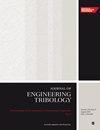纳米银添加剂对基础油的摩擦磨损机理:分子动力学模拟与实验研究
IF 1.8
3区 工程技术
Q3 ENGINEERING, MECHANICAL
Proceedings of the Institution of Mechanical Engineers, Part J: Journal of Engineering Tribology
Pub Date : 2023-08-30
DOI:10.1177/13506501231196930
引用次数: 0
摘要
虽然纳米银颗粒是常用的润滑油添加剂,但其在原子尺度上改善润滑的机理尚不清楚。本文通过分子动力学模拟,阐述了纳米银如何改善季戊四醇油酸酯润滑系统的性能。此外,使用往复式摩擦磨损试验机进行了摩擦学试验。相对浓度和模拟剪切构象表明,银纳米颗粒在剪切应力作用下发生变形,并在层间滑移处发生断裂。这导致了沉积膜的形成,覆盖了铁层的顶部和底部。我们通过分析界面相互作用能、均方位移和自扩散系数表征了季戊四醇油酸分子链与Fe层之间的相互作用。研究结果表明,银纳米颗粒的存在改善了季戊四醇油酸酯分子链在铁层上的吸附和扩散行为。摩擦学试验结果表明,在不同的润滑条件下,纳米银的加入显著降低了摩擦系数和摩擦磨损。在不同载荷和温度下加入纳米银颗粒,摩擦磨损系数的降低程度不同。当载荷为20 N,温度为298 K时,摩擦系数降低了9%,磨损降低了31%。当温度为298 K,载荷降至2 N时,摩擦系数降低8%,磨损显著降低84%。最后,在20 N的负荷下,将温度提高到373 K,摩擦系数(23%)比磨损系数(50%)的降低幅度更大。通过摩擦学试验和模拟验证了纳米银改善润滑的成膜机理。本文章由计算机程序翻译,如有差异,请以英文原文为准。
Mechanisms of friction and wear reduction by nanosilver additives to base oil: Molecular dynamics simulation and experimental study
Although nanosilver particles are commonly used as oil lubrication additives, their mechanism for improving lubrication at the atomic scale remains unclear. This article explains how the performance of a pentaerythritol oleate lubrication system can be improved using silver nanoparticles through molecular dynamics simulation. Additionally, tribological tests were conducted using a reciprocating friction and wear testing machine. The relative concentrations and simulated shear conformation revealed that silver nanoparticles underwent deformation under shear stress and fractured at the interlayer slip. This resulted in the formation of a deposited film that spread over both the top and bottom Fe layers. We characterized the interaction between pentaerythritol oleate molecular chains and Fe layers by analyzing interfacial interaction energies, mean square displacements, and self-diffusion coefficients. Our findings indicate that the presence of silver nanoparticles improves both the adsorption of pentaerythritol oleate molecular chains onto the Fe layer and their diffusion behavior. The results of tribological tests indicate that adding silver nanoparticles significantly reduces friction coefficient and frictional wear across various lubrication conditions. The addition of silver nanoparticles at different loads and temperatures resulted in varying reductions in the coefficient of friction and wear. At a load of 20 N and a temperature of 298 K, the coefficient of friction decreased by 9%, and wear decreased by 31%. When the load was reduced to 2 N while maintaining a temperature of 298 K, the coefficient of friction decreased by 8% and wear decreased significantly by 84%. Finally, at a load of 20 N but with an increased temperature to 373 K, there was a larger reduction in the coefficient of friction (23%) compared to wear (50%). The film-formation mechanism of improved lubrication by silver nanoparticles was verified through tribological tests and simulations.
求助全文
通过发布文献求助,成功后即可免费获取论文全文。
去求助
来源期刊

CiteScore
4.20
自引率
5.00%
发文量
110
审稿时长
6.1 months
期刊介绍:
The Journal of Engineering Tribology publishes high-quality, peer-reviewed papers from academia and industry worldwide on the engineering science associated with tribology and its applications.
"I am proud to say that I have been part of the tribology research community for almost 20 years. That community has always seemed to me to be highly active, progressive, and closely knit. The conferences are well attended and are characterised by a warmth and friendliness that transcends national boundaries. I see Part J as being an important part of that community, giving us an outlet to publish and promote our scholarly activities. I very much look forward to my term of office as editor of your Journal. I hope you will continue to submit papers, help out with reviewing, and most importantly to read and talk about the work you will find there." Professor Rob Dwyer-Joyce, Sheffield University, UK
This journal is a member of the Committee on Publication Ethics (COPE).
 求助内容:
求助内容: 应助结果提醒方式:
应助结果提醒方式:


